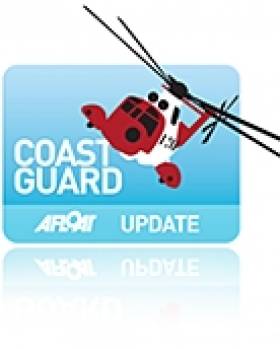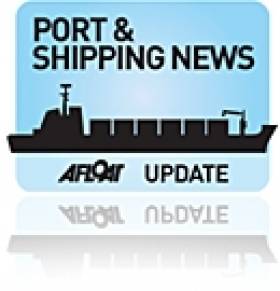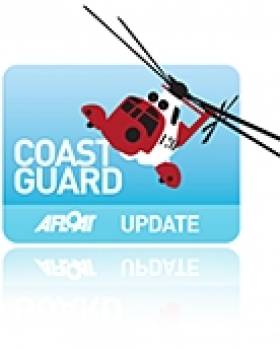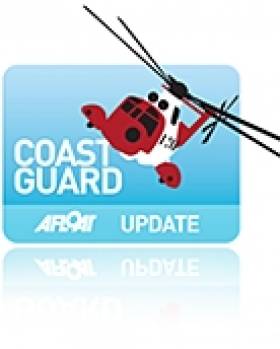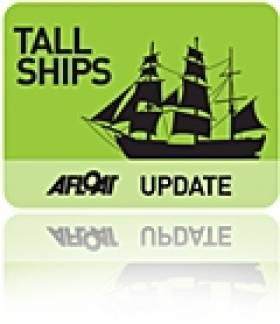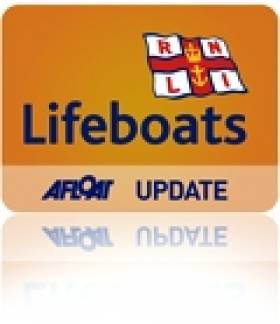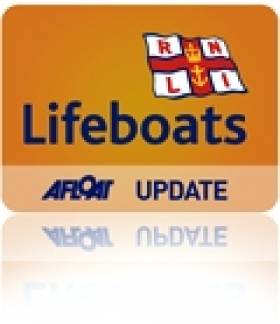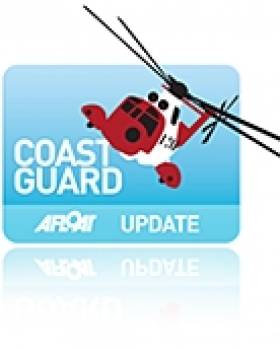Displaying items by tag: Coast Guard
Search for Bait Diggers Lost in Fog
#COASTGUARD – In two separate incidents last night Liverpool Coastguard sent resources to assist people after they became lost in fog whilst on the beach.
The first call came at 8.00 pm from a man who had been bait digging at Formby Point in Merseyside.
The fog had descended quickly and he had found himself unable to find his way back, and unable to give his position. Liverpool Coastguard sent the Crosby Coastguard Rescue Team, quad bikes from Southport Independent Rescue and teams from Mersey Fire and Rescue Service and Merseyside Police to the scene. They also maintained telephone contact with the man for the duration of the incident, asking him to listen for the resources that were searching for him and describe the location of any sounds. They also asked vessels entering the river to sound their foghorns, again to assist with pinpointing the man's location. Although the tide had been going out at the time of the man's initial call, as resources searched, the tide began coming in around him, making the search even more urgent.
At 9.15 pm, the man reported to Liverpool Coastguard that he could see the lights of a Police Land Rover and a quad bike, and so he was met by rescue crews and escorted safely off the beach.
Just after the previous incident had closed, at 9.29 pm, Liverpool Coastguard received a call from a man who had also been out bait digging, this time at Blackpool. Again, he had lost his way in the fog and the tide had begun coming in around him. Liverpool Coastguard sent the Lytham Coastguard Rescue Team and requested the RNLI send their tractor from Lytham to assist in the search, along with requesting they launch the Blackpool Inshore Lifeboats. Luckily, at 9.35 (just as the lifeboats were launching), the man phoned to say that the fog had lifted sufficiently for him to make his way back to the road, and the rescue resources were stood down.
Liverpool Coastguard Watch Manager Paul Parkes said:
"Having also dealt with an incident last week where a father and son became lost in fog and had to be treated for severe hypothermia, the risks of being out on the coast when fog descends are all too clear. We would encourage members of the public to always check the weather forecast before they go out onto the coast for any activity, and stay away from the beach when fog is forecast."
Ship Owner Fined for Overloading
#SHIPPING – At a hearing yesterday at Southampton Magistrates Court the German owners of the Antigua and Barbuda registered cargo vessel 'Katja' pleaded guilty to the overloading of their vessel which had arrived in Liverpool laden with rock salt from the St. Lawrence Seaway, Canada in November 2010.
The vessel was loaded to its marks with rock salt and sailed from Goderich to arrive at the Manchester Ship Canal on the 23rd November 2010. Rock salt was in high demand to treat UK highways at this time.

The 'Katja' - Photo: courtesy of Maritime and Coastguard Agency
As the vessel entered the River Mersey, the pilot on another passing vessel noticed that the Plimsoll Line and load lines were not visible and the vessel appeared very low in the water. When the vessel arrived in the Queen Elizabeth II Dock it was inspected by MCA Port State Control Officers who found that the load line that marks the safety limit of the vessel was submerged by 39.5 cm.
Katja Schiffahrtsges Gmbh of Haren, Ems, Germany, owner of the ship Katja, was fined £28015 plus costs of £5000 awarded to the MCA.
In summing up the Magistrates stated "We share the Maritime and Coastguard Agency's view of the seriousness of the case, however accept that the overloading was not for gain. We have also considered the early plea of guilty and have reduced the fine of £42000 accordingly.
Simon Milne, from the Maritime and Coastguard Agency said:
"Since the good work of Samuel Plimsoll, the application and enforcement of load line marks have prevented the loss of many vessels and have saved the lives of many seafarers.
Coast Guard, RNLI Funding Escapes Cuts
#COASTGUARD – Funding for the Coast Guard and the RNLI will be protected at existing levels in 2012, Minister for Transport, Tourism & Sport Leo Varadkar confirmed today (Saturday). Speaking during a New Year's Eve visit to thank volunteers at the Coast Guard Station at Howth, Co. Dublin, Minister Varadkar also confirmed that the Coast Guard would remain within the Department of Transport, Tourism & Sport.
Minister Varadkar said: 'The Coast Guard performs an essential role all year round. I would like to extend my sincere thanks to every member of staff and volunteer for their efforts during 2011. I would also like to express my gratitude to the families of all the rescuers who make it possible for the volunteers to provide this 24 hour commitment throughout the year'.
Coast Guard Director Chris Reynolds confirmed that 2011 was one of the busiest years for the Coast Guard since its foundation. The Coast Guard responded to nearly 2,000 incidents this year, resulting in 163 lives being saved and over 3,300 persons assisted. The Coast Guard helicopters alone performed 551 missions during the year. Mr Reynolds said that staying within the Department of Transport, Tourism & Sport would facilitate the Coast Guard in the further development of maritime safety in Ireland, while also retaining its existing networks.
Minister Varadkar confirmed that the Coast Guard will receive €4.37 million for current purposes again this year, not including the helicopter service, and the RNLI annual grant of €150,000 will also be retained in 2012. The Minister has also allocated capital funding to allow the Coast Guard's aging fleet to be refreshed with new vessels over the next two years. New vessels have already been allocated to Coast Guard Stations at Achill, Bunbeg, Killala, Greencastle, Doolin and Killaloe.
The Minister confirmed that he has given the OPW the go-ahead to tender for a new Coast Guard Volunteer and Pollution Response Centre in Killybegs, Co. Donegal, and he re-confirmed his commitment to proceed with a similar station in Doolin within the life of the capital expenditure programme. 2012 will also see a significant improvement in the provision of helicopter rescue services with the arrival in Ireland of the new S92A Coast Guard helicopter in Shannon at the end of January.
Meanwhile, the Coast Guard's second national telecommunications network has been commissioned, providing a completely independent back-up service for the Coast Guard ship-to-shore communication network.
Mr Reynolds said: 'Ireland is a maritime nation which has rights over an area of seabed 10 times the size of Ireland. Ninety nine per cent of our trade goes by sea and it's no surprise that most of our population lives within 30km of the coast. In carrying out our goal to prevent, prepare and respond, the men and women of the Coast Guard staff, its volunteers, our helicopter crews and our partners in the Navy, Air Corps, RNLI, CRBI and mountain rescue, have continued to provide a world-class service. This has only been possible through the incredible service offered by locally-based volunteers nationwide and the commitment of this Government to maintain these essential front line services in difficult times'.
Seven New Coast Guard Boats in €2M Safety Programme
€1.5 million has been allocated for 7 new Coast Guard boats as part of its boat renewal programme;
€300,000 will be used to purchase new vans for the Coast Guard's volunteer rescue teams;
€200,000 will be used to update the Coast Guard's pollution response equipment to best international standards.
Separately, Minister Varadkar is backing an Irish Coast Guard initiative to have a new European Coast Guard Secretariat based full-time in Dublin.
Speaking today, Minister Varadkar said: 'I'm very happy to allocate extra resources to the Coast Guard to upgrade its vital equipment, including seven new boats, along with replacement vans and pollution control materials. One of the new Rigid Inflatable Boats (RIBs) has been allocated to Achill Coast Guard, and the remainder will be allocated to Coast Guard Stations around Ireland over the next 12 months, according to priority.
"Everyone who goes to sea owes a debt of gratitude to the Coast Guard, as do their family and friends. The Coast Guard responds to emergency call-outs, and saves lives, at all hours of the day and night, throughout the year. Much of the Coast Guard's work is only possible through the large network of individual and group volunteers."
Minister Varadkar also congratulated the Director of the Irish Coast Guards, Chris Reynolds, who has been elected the new Chair of the European Union Heads of Coast Guard. The annual Heads of Coast Guards of Europe's meeting will now take place in Dublin next August.
Mr Reynolds has been asked specifically to prepare the ground for a permanent Secretariat, manned by Coast Guard Officers from Member States, the EU Commission and various agencies. The Secretariat will meet in Dublin for its inaugural year, and Mr Reynolds will propose to have the Secretariat based in Dublin on a permanent basis.
Additional info:
New Delta 900 SUPER X RIBs for Irish Coastguard
The Irish Coastguard's new Delta 900 SUPER X Coast Guard RIBs are 9.00m overall and will be in service off the Republic of Ireland's coast.Jun 07, 2011 - From its early days in 1979, the Delta Power Group (builder of Delta RIBs) has grown to become one of the most successful and highly regarded designers and builders of commercial RIBs for the world market.
This enviable position has been achieved through a simple business philosophy. Delta has not burdened itself with debt to fuel growth, preferring to expand organically by concentrating on contracts that remain strictly within its targeted commercial sector, winning business from successful organisations; which in turn generates repeat orders and new contacts.
A recent Irish Coastguard contract is not for just one craft; but covers a five year programme to supply 12 highly specified boats. Delta's Military and Law Enforcement range comprises nine models and these are offered with different specifications depending on usage.
The Irish Coastguard's new Delta 900 SUPER X Coast Guard RIBs are 9.00m overall and will be in service off the Republic of Ireland's coast. Twin Yamaha F225B engines give a maximum speed of 40 knots and a cruising speed of 32 knots. Safety equipment is to MSO P6 Passenger Boat and other equipment is to MCA Category 3 rating. The extensive specification includes Shockwave mitigating seating for all the crew. And it also features Delta's standard procedure of terminating all wiring looms in fully waterproof housings with Deutsch connectors to ensure maximum in service reliability; essential, since the Irish Sea and Atlantic Ocean can throw up very demanding operational conditions.
In addition, Delta is one of the few major Commercial RIB builders to run the processes of laminating, tube making and outfitting completely 'in house' (on its wholly owned and secure 2.2 Acre freehold site) in 79,000 sq.ft of covered space. This ensures maximum Management and Quality Control. Delta is certified to ISO 9001: 2008 and is able to build under full survey of all the major Classification Societies.
As a result, Delta's extensive international client base now includes ERRV, Marine Police, Border Control, Customs & Excise, Navies, Special Forces, Coastguards, Search & Rescue services, Law enforcement agencies, Military and Port Authorities; to name just a few.
Kitesurfer Rescued off Liverpool
Liverpool Coastguard was contacted by Wirral Lifeguards who had been watching a kite surfer who had returned to sea to retrieve his lost kite in strong winds and a choppy sea. The kite which he was using was seen to come down in the sea. Lifeguards used a jet ski to look for the kite surfer but on arrival at the scene could only find two kites and no kite surfer.
Liverpool Coastguard requested the attendance of RNLI New Brighton inshore lifeboat and a rescue helicopter from RAF Valley and a search began for the kite surfer.
The kite surfer was located by the lifeboat about a mile offshore and recovered to shore.
Liverpool Coastguard Watch Manager Paul Parkes says,
"The kite surfer was lucky to be found because it is hard to spot a head in a black wet suit in choppy water like today. The combination of strong offshore winds and an outgoing tide created difficult conditions for making back to shore. Fortunately he was able to lift his board up out of the water when he heard the lifeboat engines in his vicinity.
Coastguard warns water sports enthusiasts to always check conditions and tides before setting off. Don't go alone and always wear a personal flotation device, (PFD). Wear bright clothing which will help you be located if you get into difficulty."
However, from June 30-July 3, when the ships are moored in Waterford and when we do go down to the quays to see them, the public must be aware of the dangers associated with closeness to water and be actively responsible for their own safety and that of their children! No doubt, every precaution will be taken to ensure as far as is practical that safety precautions and rescue equipment are in place for your protection. However, this does not alter the responsibility we have for our own personal safety and that of our children at all times.
For this reason, the host port team for the Tall Ships visit will have in place comprehensive safety and management arrangements, coupled with regimes for rescuing people in the event of a water related accident. Again, this in no way relieves any visitor to the quaysides of responsibility for their own personal water craft and all on board and the safety and care of all.
Therefore:
Do not go too near to the quayside edges; remember falling down between a quay and a boat is one of the most difficult places to get rescued from.
If anxious to see or visit a particular Tall Ship, don't push those in front of you towards the water's edge. Take your time; the ships are in Waterford over three days.
If going on board any boat or ships, never jump from the quay onto the boat, or indeed from boat to boat. Always use a gangplank if available. If not, you must take extreme care when crossing.
Excessive alcohol and water do not mix. Therefore, visitors to the quaysides should ensure that they do not have excessive drink taken.
Those who invite people on board their vessels, regardless of size, must take a responsible approach to the availability of alcohol - bearing in mind the inherent dangers of being on board a vessel at all times under the influence of any alcoholic drink.
Do not climb on or over any railings, walls or other barriers that protect the quays from the water.
On smaller vessels, there is a definite legal requirement in relation to wearing life-jackets and one should be familiar with this requirement.
Ringbuoys and other lifesaving equipment placed on the quaysides should not under any circumstance be interfered with, they are provided to save lives in the event of someone falling into the water.
For those afloat, MARINE NOTICE 047 of 2011 has significance and all should make themselves aware of this important document which covers all recreational craft afloat and the responsibilities with regard to their vessel.
In conclusion, it behoves every person to ensure that The Tall Ships Races will be a safe and memorable occasion to visit Waterford with its noble quays, a once-in-a-lifetime spectacle to have seen and enjoyed by all who visit the city and port.
Calling "112" or "999"- Ask for the "Coast Guard".
If you see someone in trouble in the water (or you think someone is in trouble) don't hesitate to dial one of the emergency numbers (112 or 999) and ask to be put through to the "Coast Guard". When you are connected to the Coast Guard, give a brief description of what you saw and the Coast Guard will decide on the necessary action to take.
Remember! Always ask for the Coast Guard, as this will avoid any unnecessary delay by being connected to the wrong service particularly if someone is in trouble in the water. During the Tall Ships visit to Waterford should a telephone not be available ask any Garda, Civil Defence Officer or other steward on duty for help.
Dun Laoghaire Lifeboats Aid Three People During Boat Drama
Four people were on board the craft when they got into difficulties off Shanganagh cliffs between Killiney and Bray. One person swam to shore to raise the alarm, two clung to a buoy while another was reported missing.
The RNLI's all-weather (ALB) lifeboat and inshore lifeboat launched at 14.08pm and proceeded to the scene, arriving 15 minutes later.
Dun Laoghaire RNLI volunteer crew recovered two of the casualties on board the inshore lifeboat while the Irish Coast Guard rescue helicopter 116 located the missing person in the water. All three were transfered to the helicopter and taken to Tallaght Hospital for treatment.
Conditions were described as fresh with force four to five winds.
The incident occurred shortly after 10pm when the man was walking on a sandbank approximately one mile from Strand Road in Sandymount when he became aware that he was cut-off by the rising flood tide. The Irish Coastguard service that co-ordinates marine rescue received a phone call from the casualty and the inshore lifeboat was launched at 10.20pm.
A search involving Gardai and coastguard shore units was already underway and the ILB began combing the area with the assistance of searchlights and white parachute flares. The casualty relayed his position to the ILB crew via the Dublin Coastguard radio service and was located within 20 minutes.
The ILB crew took the casualty on board and brought him to Dun Laoghaire one hour after the call-out. He was unhurt in the incident and did not require hospital attention.
The new inshore lifeboat was named "Realt Na Mara" by broadcaster Pat Kenny and his wife Cathy at a ceremony last Saturday. The €35,000 craft was donated privately and this evening's call was the second today. Earlier, four people on a small powerboat got into difficulties off Bulloch Harbour in Dalkey.
Tonight's incident is not an infrequent occurrence as the sandbanks on Sandymount Strand have tricked other walkers in the past as the incoming tide floods the lower-lying beach area closer to the shore and depths become impossible to walk, especially in surf.
"The casualty was very lucky to escape injury or worse," commented Stephen Wynne, Lifeboat Operations Manager at Dun Laoghaire RNLI. "There was less than two hours remaining before high-water but at that stage the sandbank would have been completely covered. Sea-temperatures on the East Coast are still less than ten degrees and the chances of survival would have been slim".
False Alarm for Kitesurfer 'Pulled Out to Sea'
A number of local Search and Rescue Units were involved in the search for a Kite Surfer who was seen being pulled out to sea approximately 3 miles off Balaggan Point, Co Louth yesterday, according to SAR Ireland.
Full CH 67 Comms below.
Kilkeel, Greenore and later Clogher Head lifeboats were all involved along with a passing yacht as they raced in pursuit of what was thought to be an out of control Kite Surfer as he was spotted being pulled out across Dundalk Bay.
Clogher Head lifeboat eventually managed to catch up with the surfer who it turned out was being towed by a jetski, had a VHF handheld and was in no danger whatsoever.
All units were stood down and told to return to base.
Both Belfast and Dublin CG Co-ordinated at different intervals of this search.
Baltimore Lifeboat Rescues Man Overboard
Valentia Coast Guard alerted the Baltimore lifeboat station at 12:43pm and both the inshore lifeboat Bessie and the all-weather lifeboat Hilda Jarrett put to sea. The twin engined Atlantic 75 which has a top speed of 32 knots, reached the casualty within 20 minutes under the direction of Helmsman Youen Jacob.
Crewman Ronan Callanan administered oxygen to the stricken fisherman stabilising his condition, which had been serious due to long immersion in water. Further medical attention was offered by all weather lifeboat crewman Jerry Smith when it arrived on scene 20 minutes later.
Given the seriousness of the fishermans condition it was decided that an airlift was the most appropriate course of action and a rescue helicopter was called.
Helmsman Youne Jacob, commended the Captain and crew of the fishing boat in retrieving the fisherman from the water, which was made even more difficult by the choppy sea conditions prevailing.
The Inshore lifeboat then returned to Baltimore Harbour, However the allweather lifeboat remained at seas, as another distress call was received from a fishing vessel adrift 30 miles offshore.
In current weather conditions it will take them two hours to reach the vessel and several more to tow her back to shore.
Onboard the inshore lifeboat were Helmsman Youen Jacob, crewmen Ronan Callanan and Tadhg Collins.
On board the all weather lifeboat are coxswain Aidan Bushe, Cathal Cottrell, Jerry Smith, Ronnie Carty and father and son team Pat and Diarmuid Collins


























